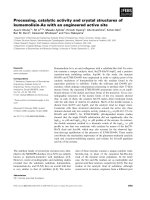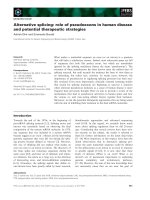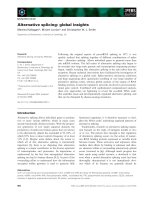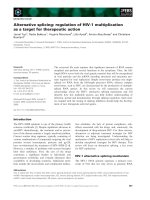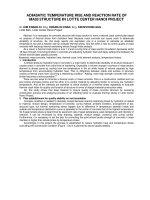Báo cáo khoa học: Alternative splicing: good and bad effects of translationally silent substitutions pdf
Bạn đang xem bản rút gọn của tài liệu. Xem và tải ngay bản đầy đủ của tài liệu tại đây (181.57 KB, 5 trang )
MINIREVIEW
Alternative splicing: good and bad effects of
translationally silent substitutions
M. Raponi and D. Baralle
Academic Unit of Genetic Medicine, Human Genetics Division, University of Southampton, Southampton General Hospital, UK
Introduction
Splicing is an important part of a post-transcriptional
mechanism where introns are removed and exons are
joined together, allowing the resulting mature mRNA
to be translated into a specific protein product. This
mechanism is supported by the spliceosome machine,
which recognizes the well-characterized splicing con-
sensus sequences at the exon–intron junctions (donor
and acceptor sites) and their proximities (branch
points). Other cis-acting elements involved in the deter-
mination of the splicing outcome are recognized by
trans-acting factors that can either act as splicing
silencers or enhancers.
Alteration of splicing may occur whenever cis varia-
tions alter the recognition of splicing regulatory
sequences [1,2]. This could result in altered isoform
proportions, activation of a control mechanism such as
nonsense-mediated decay, as well as the creation or
loss of splicing variants. As this process has a signifi-
cant impact on protein abundance and ⁄ or functional-
ity, it follows that sequence variants in translationally
silent exonic positions that modify splicing are crucial
in genetic diagnosis and their role as a possible cause
of disease cannot be ignored. Equally important is the
role that these silent sequences may have in evolution.
For example, many algorithms used to calculate evolu-
tionary distances are normalized against the transla-
tionally ‘silent’ sequence variants, which until recently
were considered evolutionarily neutral. We now know
that many so-called neutral substitutions are instead
causative, as they produce the skipping of the exon or
Keywords
minigene; NF1; pre-mRNA; silent; splicing;
translation
Correspondence
D. Baralle, Academic Unit of Genetic
Medicine, Human Genetics Division,
University of Southampton, Duthie Building
(Mailpoint 808), Southampton General
Hospital, Tremona Road, Southampton
SO16 6YD, UK
Fax: +44 2380794346
Tel: +44 2380796162
E-mail:
(Received 26 August 2009, revised 4
November 2009, accepted 17 November
2009)
doi:10.1111/j.1742-4658.2009.07519.x
Nucleotide variations that do not alter the protein-coding sequence have
been routinely considered as neutral. In light of the developments we have
seen over the last decade or so in the RNA processing and translational
field, it would be proper when assessing these variants to ask if this change
is neutral, good or bad. This question has been recently partly addressed
by genome-wide in silico analysis but significantly fewer cases by laboratory
experimental examples. Of particular relevance is the effect these mutations
have on the pre-mRNA splicing pattern. In fact, alterations in this process
may occur as a consequence of translationally silent mutations leading to
the expression of novel splicing isoforms and ⁄ or loss of an existing one.
This phenomenon can either generate new substrates for evolution or cause
genetic disease when aberrant isoforms altering the essential protein func-
tion are produced. In this review we briefly describe the current under-
standing in the field and discuss emerging directions in the study of the
splicing mechanism by integrating disease-causing splicing mutations and
evolutionary changes.
Abbreviations
K
a
, ratio of nonsynonymous substitutions; K
s
, ratio of synonymous substitutions.
836 FEBS Journal 277 (2010) 836–840 ª 2010 The Authors Journal compilation ª 2010 FEBS
changes in the alternative splicing (AS) isoforms (that
become substrates of both positive and negative
natural selection).
Two main categories of translationally silent varia-
tions can alter splicing: (a) intronic variations – changes
outside the coding exonic sequence; (b) synonymous
changes – variations that alter the exonic sequence, but
not the codon information, for an amino acid.
Translationally silent variations that
affect splicing and disease
Clinical studies identifying aberrant splicing mutations
are of great importance for genetic counselling, as a
good proportion of unclassified variants are often
found to be the cause of inappropriate RNA process-
ing (recently reviewed by Baralle et al. [3]). Such vari-
ants affecting splicing can be classified as pathogenic
mutations or genetic variations causing predisposition
to disease. The first category usually has a devastating
effect on splicing, with a substantial loss of original
protein function or even acquisition of an antagonistic
function. An explanation for the second category relies
on the fact that a weakly tolerated effect on splicing
can be enhanced by additional phenomena such as
affected expression of trans-acting factors that regulate
splicing [4].
Both intronic and synonymous nucleotide substitu-
tions can sufficiently alter splicing and cause genetic dis-
ease. A list of silent mutations associated with altered
splicing was reported by Cartegni et al. [5]. However,
the number of examples reported to date in the litera-
ture is not as large as expected and this may be because
synonymous variations have previously always been
considered neutral and because of an existing bias to
search for alterations in the protein functional ⁄ struc-
tural properties. Likewise, deep intronic variations that
do not affect the canonical splice sites have rarely been
taken into consideration or even reported owing to
technical difficulties in sequencing entire genes (also
until recently an expensive task) and in the underappre-
ciated belief that sequence variations far away may
affect far away splicing signals. With increased aware-
ness we predict that this will change in the future.
There are a number of different ways that such
variations may affect splicing, including:
l
disruption of exonic ⁄ intronic splicing enhancer ⁄ silen-
cer sequences or creation of exonic ⁄ intronic splicing
silencer ⁄ enhancer sequences;
l
alteration of RNA secondary structure;
l
creation or disruption of splice sites;
In addition to the clinical importance of discovering
the aberrant effect of such mutations, they also repre-
sent an essential clue and wealthy resource for the
study of novel splicing regulatory mechanisms. There
is substantial precedence for identifying novel splicing
regulatory sequences and splicing factors by molecular
analysis of splicing aberrations caused by disease-caus-
ing mutations.
A good example of this was the mechanistic study
of a deep intronic GTAA deletion in the ATM gene
that permitted the identification of a novel intronic
splicing processing element [6]. Further functional
studies have shown how U1 binding to such intronic
elements can inactivate the inclusion of aberrant exons
[7].
Studies of this kind provide significant insights into
the splicing regulation of many genes, but this
approach has been poorly undertaken with regards to
synonymous changes that affect splicing.
Apart from synonymous variations causing disease
by creating or affecting the canonical splice sites, most
of them still lack experimental approaches directed at
identifying the exact mechanism involved. In spite of
the well-known lack of reliability of in silico
approaches, many of the synonymous changes causing
aberrant splicing are thought to alter exonic silencer ⁄
enhancer sequences only on this basis [8,9]. For instance,
a silent mutation in exon 7 of the POMGNT1 gene, in a
patient with congenital muscular dystrophy, was shown
to promote skipping of this exon. Here an extensive
in silico analysis predicted the creation of various splic-
ing regulatory sequences, including an exon splice silen-
cer, as well as a change in secondary structure [8].
Another more characterized example comes from an
in silico analysis of two PDHA1 exon 5 silent variants.
Each variant determines exon 5 skipping and were pre-
dicted to disrupt the splice enhancer SRp55 motif.
Using a minigene system, the inefficient exon 5 inclu-
sion was corrected by strengthening the intron 5 donor
site, suggesting that the putative SRp55 motif compen-
sates for the weak donor site [9].
Translationally silent variations that
affect splicing and evolution
With increasing understanding of the importance of cis
regulatory sequences located either in the introns or in
the coding sequence for the splicing process, the scien-
tific world has become aware that there is a selective
constraint for evolution, not only against sequence
variations that alter the protein information, but also
against variations that are harmful for the splicing pro-
cess. As the last category includes even supposedly
silent changes, which do not alter the amino acid
code, it follows that both intronic and synonymous
M. Raponi and D. Baralle Alternative splicing
FEBS Journal 277 (2010) 836–840 ª 2010 The Authors Journal compilation ª 2010 FEBS 837
variations are not neutral for evolution. Understanding
this has important consequences in the way routine
diagnostic testing is approached.
In addition, the concept of non-neutrality for synon-
ymous variations will force an adjustment of the tradi-
tional way of measuring sequence evolution based on
the K
a
⁄ K
s
ratio (where K
a
is the ratio of nonsynony-
mous substitutions and K
s
is the ratio of synonymous
substitutions). This method, where the metric is based
on the neutrality of K
s
, has now become relatively
inaccurate. Although this approach is still in use,
researchers are aware that the K
s
may not always be
neutral, but is potentially affected by at least the splic-
ing constraint. As a consequence, a new approach has
emerged where the detection of K
a
⁄ K
s
ratio peaks in
genes, using a sliding window analysis, is assumed to
be an index of selective constraint acting on silent sites.
An example of this type of approach is a fascinating
conservation analysis comparing BRCA1 orthologues
where the aligned coding sequences were used for two
independent sliding window analyses (mouse–rat and
human–dog) [10]. This analysis showed a strong puri-
fying selection at silent sites in a critical region of this
gene [10], spanning the 3¢ end of exon 10 and the 5¢
end of exon 11. Purifying selection is the force that
drives negative selection to eliminate deleterious muta-
tions that would otherwise alter protein function. The
possibility that this biased synonymous codon usage
reflects the necessity to maintain regulatory sequences
associated with splicing regulation was subsequently
suggested by the identification of two putative exon
splicing enhancers within the critical region [11].
However, this type of approach contains several pit-
falls, and it is important to acknowledge the existence
of recent bioinformatic studies showing that the synon-
ymous substitution rate reduction observed with the
sliding window analysis may often be artefactual
[12,13]. As a result, there is a strong recommendation
that all these studies should be complemented by fur-
ther experimental support to demonstrate purifying
selection at silent sites in the gene of interest and to
demonstrate that such constraint is necessary to main-
tain correct splicing of the gene.
In fact, although we acknowledge that codon bias is
a potential index of splicing constraint, it should not
be forgotten that other selective forces may act at
silent sites, such as translational accuracy, mRNA
binding and mRNA stability (for a review see [14]). In
addition, missense variations can also affect splicing.
Therefore, a low K
a
may not only represent negative
selection at amino acid substitution, but also splicing
constraint. Therefore, the detection of both lower K
a
and K
s
in one region is probably an index of splicing
constraint rather than the detection of K
a
⁄ K
s
peaks,
which may be due to a high K
a
ratio and not to selec-
tive constraint at silent sites.
Notwithstanding the controversy surrounding the
measurement of purifying selection at silent sites, the
fact that synonymous substitutions are under selective
constraint because they have to ensure splicing effi-
ciency has already been experimentally demonstrated
for the CFTR gene [15]. In addition to reporting that
30% of the synonymous substitutions in human
CFTR exon 12 significantly reduce its inclusion, this
study has also brought new evidence that protein func-
tion optimization can be constrained in exchange for
the maintenance of proper splicing efficiency. These
results were confirmed by an additional evolutionary
study that used CFTR exon 12 as a model and showed
suboptimal composition at silent sites for splicing effi-
ciency in the human exon and proposed a way by
which exon loss may represent a substrate for evolu-
tion when a combination of synonymous changes
induce partial exon skipping [16].
From an evolutionary point of view, however, the
most frequently described substrate for natural selec-
tion of new splicing variants is exon gain, although, as
for exon loss, the precondition that allows a new splic-
ing variant to evolve freely is the maintenance of origi-
nal protein function. Therefore, nucleotide variations
that preserve the coding capacity (such as synonymous
or intronic substitutions), but also induce the inclusion
of a new exon in only a minor fraction of the mature
transcript represent the best candidates in the creation
of new splicing substrates for evolution. In this way,
the newly generated alternative splicing exon has a bet-
ter chance of being tolerated by the cell metabolism
and is then free to evolve.
Integrating evolutionary and splicing
disease-related mechanistic studies –
an example
The importance of clinical studies is not simply to
obtain important knowledge that a mutation has
caused a splicing defect, but also to provide a clue for
subsequent splicing functional studies, therapeutic
approaches and further elucidation of this complex
and interesting system. Evolutionary studies represent
another important field for the investigation of the ele-
ments involved in splicing regulation and the integra-
tion of all these approaches will give us the best
chance of finally understanding the splicing mechanism
itself.
An example from our own laboratory is the NF1
splicing mutation c.293–279A>G. This mutation was
Alternative splicing M. Raponi and D. Baralle
838 FEBS Journal 277 (2010) 836–840 ª 2010 The Authors Journal compilation ª 2010 FEBS
found to activate a pseudoexon and subsequent experi-
ments showed a novel mechanism by which the levels
of polypyrimidine tract binding proteins limit the
damaging pseudoexon inclusion [17]. The discovery of
such repression is of great relevance for further gene
therapy applications rescuing the patient’s wild-type
phenotype. This dependency on trans-acting factor
expression levels may also represent an important
observation with regards to explaining the variable
characteristics of disease, such as why particular
organs are affected by a mutation, age of onset,
individual susceptibilities, etc.
In addition, this discovery also brings insight into
the speculation that evolutionary changes may protect
against aberrant splicing due to a mutation as well as
predispose to disease. Indeed, the same variation is nor-
mally present in the canine gene sequence where no
splicing alteration is observed. As shown in Fig. 1, we
demonstrated the compensatory relevance of some nu-
cleotides that differentiate the dog sequence from
human. Canine nucleotide substitution in the human
minigene for splicing assay harbouring the c.293–
279A>G mutation was enough to mimic the normal
pseudoexon exclusion observed in dog and in human
normal phenotypes. These data make it clear that com-
pensatory changes in dog protect against additional
variations that would produce intron exonization. Con-
versely, in the human there is a predisposition to muta-
tions causing pseudoexon inclusion in NF1 intron 30,
which is only partially counteracted by the presence of
polypyrimidine tract binding protein binding sites.
However, it would be wrong to conclude that evolu-
tionary changes happening in human introns should be
considered ‘bad’ because of a predisposition to aber-
rant splicing, as this may not represent the whole story.
In fact, from an evolutionary point of view, the procliv-
ity of human intron 30 to exonize may be ‘good’ if
looked at as the ability to produce a new substrate for
evolution, as previously suggested [18]. Indeed, the loss
of the intronic A>G variation from dog versus human,
which creates a functional acceptor splice site only in
combination with the human cryptic donor site 171 nu-
cleotides downstream, has probably allowed the crea-
tion of the latter. Overall, this donor site is probably
alternatively spliced in humans to produce a minor
fraction of transcripts where 67 nucleotides of intron
30 are retained [18]. Such tolerated splicing variants
can evolve freely in the pseudointronic sequence and
thus acquire a new function.
In conclusion, we need to reassess our view of nucle-
otide variations that were previously considered neu-
tral, particularly with regards to their effect on splicing.
A variety of tools are available to us for this purpose
and further investigation of these sequence variants will
not only further our understanding of the splicing
mechanism and improve clinical diagnostic testing, but
is also important for understanding gene evolution.
References
1 Pagani F & Baralle FE (2004) Genomic variants in
exons and introns: identifying the splicing spoilers. Nat
Rev Genet 5, 389–396.
2 Cooper TA & Mattox W (1997) The regulation of
splice-site selection, and its role in human disease. Am J
Hum Genet 61, 259–266.
3 Baralle D, Lucassen A & Buratti E (2009) Missed
threads. The impact of pre-mRNA splicing defects on
clinical practice. EMBO Rep 10, 810–816.
4 Nissim-Rafinia M & Kerem B (2005) The splicing
machinery is a genetic modifier of disease severity.
Trends Genet 21, 480–483.
5 Cartegni L, Chew SL & Krainer AR (2002) Listening
to silence and understanding nonsense: exonic muta-
tions that affect splicing. Nat Rev Genet 3, 285–298.
6 Pagani F, Buratti E, Stuani C, Bendix R, Do
¨
rk T &
Baralle FE (2002) A new type of mutation causes a
splicing defect in ATM. Nat Genet 30, 426–429.
Fig. 1. Human–dog inactivating substitutions completely repress pseudoexon inclusion. The pseudoexon sequence in uppercase is
compared with the dog (Canis familiaris) sequence. Asterisks indicate nucleotide matches and dashes indicate sequence gaps. The )279
a>g mutation and the nucleotide substitutions of human versus dog pseudoexon sequence are shown (t1 = G>T; t2 = A>T; g1 = A>G;
g2 = T>G). Transfection in Hela cells of hybrid minigenes carrying both single and combinations of substitutions always show pseudoexon
exclusion (data not shown).
M. Raponi and D. Baralle Alternative splicing
FEBS Journal 277 (2010) 836–840 ª 2010 The Authors Journal compilation ª 2010 FEBS 839
7 Lewandowska MA, Stuani C, Parvizpur A, Baralle FE
& Pagani F (2005) Functional studies on the ATM
intronic splicing processing element. Nucleic Acids Res
33, 4007–4015.
8 Oliveira J, Soares-Silva I, Fokkema I, Gonc¸ alves A,
Cabral A, Diogo L, Gala
´
n L, Guimara
˜
es A, Fineza I,
den Dunnen JT et al. (2008) Novel synonymous substi-
tution in POMGNT1 promotes exon skipping in a
patient with congenital muscular dystrophy. J Hum
Genet 53, 565–572.
9 Boichard A, Venet L, Naas T, Boutron A, Chevret L, de
Baulny HO, De Lonlay P, Legrand A, Nordman P &
Brivet M (2008) Two silent substitutions in the PDHA1
gene cause exon 5 skipping by disruption of a putative
exonic splicing enhancer. Mol Genet Metab 93, 323–330.
10 Hurst LD & Pa
´
l C (2001) Evidence for purifying selec-
tion acting on silent sites in BRCA1. Trends Genet
17(2), 62–65.
11 Orban TI & Olah E (2001) Purifying selection on silent
sites – a constraint from splicing regulation? Trends
Genet 17, 252–253.
12 Schmid K & Yang Z (2008) The trouble with sliding
windows and the selective pressure in BRCA1. PLoS
ONE 3, e3746. Erratum PLoS ONE 3(11), e3746.
13 Parmley JL & Hurst LD (2007) How common are
intragene windows with KA > KS owing to purifying
selection on synonymous mutations? J Mol Evol 64,
646–655.
14 Parmley JL & Hurst LD (2007) How do synonymous
mutations affect fitness? Bioessays 29, 515–519.
15 Pagani F, Raponi M & Baralle FE (2005) Synonymous
mutations in CFTR exon 12 affect splicing and are not
neutral in evolution. Proc Natl Acad Sci USA 102,
6368–6372.
16 Raponi M, Baralle FE & Pagani F (2007) Reduced
splicing efficiency induced by synonymous substitutions
may generate a substrate for natural selection of new
splicing isoforms: the case of CFTR exon 12. Nucleic
Acids Res 35, 606–613.
17 Raponi M, Buratti E, Llorian M, Stuani C, Smith CW
& Baralle D (2008) Polypyrimidine tract binding protein
regulates alternative splicing of an aberrant pseudoexon
in NF1. FEBS J 275, 6101–6108.
18 Raponi M, Upadhyaya M & Baralle D (2006)
Functional splicing assay shows a pathogenic
intronic mutation in neurofibromatosis type 1 (NF1)
due to intronic sequence exonization. Hum Mutat 27,
294–295.
Alternative splicing M. Raponi and D. Baralle
840 FEBS Journal 277 (2010) 836–840 ª 2010 The Authors Journal compilation ª 2010 FEBS

